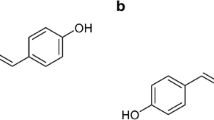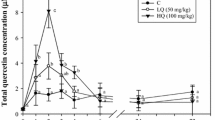Abstract
Purpose. Resveratrol, a phenolic phytoalexin occurring in grapes, wine, peanuts, and cranberries, has been reported to have anticarcinogenic, antioxidative, phytoestrogenic, and cardioprotective activities. Because little is known about the metabolism of this potentially important compound, the in vitro and in vivo metabolism of trans-resveratrol were investigated.
Methods. The in vitro experiments included incubation with human liver microsomes, human hepatocytes, and rat hepatocytes and the in vivo studies included oral or intraperitoneal administration of resveratrol to rats and mice. Methanol extracts of rat urine, mouse serum, human hepatocytes, rat hepatocytes, and human liver microsomes were analyzed for resveratrol metabolites using reversed-phase high-performance liquid chromatography with on-line ultraviolet-photodiode array detection and mass spectrometric detection (LC-DAD-MS and LC-UV-MS-MS). UV-photodiode array analysis facilitated the identification of cis- and trans-isomers of resveratrol and its metabolites. Negative ion electrospray mass spectrometric analysis provided molecular weight confirmation of resveratrol metabolites and tandem mass spectrometry allowed structural information to be obtained.
Results. No resveratrol metabolites were detected in the microsomal incubations, and no phase I metabolites, such as oxidations, reductions, or hydrolyzes, were observed in any samples. However, abundant trans-resveratrol-3-O-glucuronide and trans-resveratrol-3-sulfate were identified in rat urine, mouse serum, and incubations with rat and human hepatocytes. Incubation with β-glucuronidase and sulfatase to release free resveratrol was used to confirm the structures of these conjugates. Only trace amounts of cis-resveratrol were detected, indicating that isomerization was not an important factor in the metabolism and elimination of resveratrol.
Conclusion. Our results indicate that trans-resveratrol-3-O-glucuronide and trans-resveratrol-3-sulfate are the most abundant metabolites of resveratrol. Virtually no unconjugated resveratrol was detected in urine or serum samples, which might have implications regarding the significance of in vitro studies that used only unconjugated resveratrol.
Similar content being viewed by others
REFERENCES
M. B. Sporn, N. M. Dunlop, D. L. Newton, and J. M. Smith. Prevention of chemical carcinogenesis by vitamin A and its synthetic analogs (retinoids). Fed. Proc. 35:1332–1338 (1976).
W. K. Hong and M. B. Sporn. Recent advances in chemoprevention of cancer. Science 278:1073–1074 (1997).
M. Jang, L. Cai, G. O. Udeani, K. V. Slowing, C. F. Thomas, C. W. W. Beecher, H. H. S. Fong, N. R. Farnsworth, A. D. Kinghorn, R. G. Mehta, R. C. Moon, and J. M. Pezzuto. Cancer chemopreventive activity of resveratrol, a natural product derived from grapes. Science 275:218–220 (1997).
M. Jang and J. M. Pezzuto. Cancer chemopreventive activity of resveratrol. Drugs Exp. Clin. Res 25:65–77 (1999).
J. A. Bailey. Mechanism of phytoalexin accumulation. In Phytoalexins, eds. J. A. Baily and J. W. Manfield, pp. 289–318, Wiley, New York, 1982.
Y. Wang, F. Catana, Y. Yang, R. Roderick, and R. B. van Breemen. Analysis of resveratrol in grape products, cranberry juice and wine using liquid chromatography-mass spectrometry. J. Agric. Food Chem. 50:431–435 (2002).
E. N. Frankel, A. L. Waterhouse, and J. E. Kinsella. Inhibition of human LDL oxidation by resveratrol. Lancet 341:1103–1104 (1993).
N. J. Miller and C. A. Rice-Evans. Antioxidant activity of resveratrol in red wine-to the editor. Clin. Chem. 41:1789 (1995).
B. Fuhrman, A. Lavy, and M. Aviram. Consumption of red wine with meals reduces the susceptibility of human plasma and lowdensity-lipoprotein to lipid-peroxidation. Am. J. Clin. Nutr. 42: 549–554 (1995).
A. A. E. Bertelli, L. Giovannini, D. Giannesi, M. Migliori, W. Bernini, M. Fregoni, and A. Bertelli. Antiplatelet activity of synthetic and natural resveratrol in red wine. Int. J. Tissue React. 17:1–3 (1995).
C. R. Pace-Asciak, S. E. Hahn, E. P. Diamandis, G. Soleas, and D. M. Goldberg. The red wine phenolics trans-resveratrol and quercetin block human platelet-aggregation and eicosanoid synthesis-Implications for protection against coronary heartdisease. Clin. Chim. Acta 235:207–219 (1995).
Y. Kimura, H. Okuda, and S. Arichi. Effects of stilbenes on arachidonate metabolism in leukocytes. Biochim. Biophys. Acta 834: 275–278 (1985).
S. Sotheeswaran and V. Pasupathy. Distribution of resveratrol oligomers in plants. Phtyochemistry 32:1083–1092 (1993).
P. Kopp. Resveratrol, a phytoestrogen found in red wine. A possible explanation for the conundrum of the “French paradox”? Eur. J. Endocrinol. 138:619–620 (1998).
R. Lu and G. Serrero. Resveratrol, a natural product derived from grape exhibits antiestrogenic activity and inhibits the growth of the human breast cancer cells. J. Cell Physiol. 179:297–304 (1999).
D. K. Das, M. Sato, P. S. Ray, G. Maulik, R. M. Engelman. A. A. E. Bertelli, A. Bertelli. Cardioprotection of red wine: Role of polyphenolic antioxidants. Drugs Exptl. Clin. Res. 25:115–120 (1999).
C. R. Pace-Asciak, O. Rounova, S. E. Hahn, E. P. Diamandis, and D. M. Goldberg. Wines and grape juices as modulation of platelet aggregation in healthy human subjects. Clin. Chim. Acta. 246:163–182 (1996).
A. A. E. Bertelli, L. Giovannini, R. Stradi, S. Urien, J.-P. Tillement, and A. Bertelli. Kinetics of trans-and cis-resveratrol (3,4',5-trihydroxystilbene) after red wine oral administration in rats. Int. J. Clin. Pharm. Res. 16:77–81 (1996).
W. Andlauer, J. Kolb, K. Siebert, and P. Fürst. Assessment of resveratrol bioavailability in the perfused small intestine of the rat. Drugs Exptl. Clin. Res. 26:47–55 (2000).
G. Kuhnle, J. P. Spencer, G. Chowrimootoo, H. Schroeter, E. S. Debnam, S. K. S. Srai, C. Rice-Evans, and U. Hahn. Resveratrol is absorbed in the small intestine as resveratrol glucuronide. Biochem. Biophys. Res. Commun. 272:212–217 (2000).
C. De Santi, A. Pietrabissa, R. Spisni, F. Mosca, and G. M. Pacifici. Sulphation of resveratrol, a natural product present in grapes and wine, in human liver and duodenum. Xenobiotica 30:609–617 (2000).
C. De Santi, A. Pietrabissa, R. Spisni, F. Mosca, and G. M. Pacifici. Sulphation of resveratrol, a natural product present in wine, and its inhibition by natural flavonoids. Xenobiotica 30:857–866 (2000).
C. De Santi, A. Pietrabissa, F. Mosca, and G. M. Pacifici. Glucuronidation of resveratrol, a natural product present in grape and wine, in the human liver. Xenobiotica 30:1047–1054 (2000).
A. P. Li, C. Lu, J. A. Brent, C. Pham, A. Fackett, C. E. Ruegg, and P. M. Silber. Cryopreserved human hepatocytes: characterization of drug-metabolizing enzyme activities and applications in higher throughput screening assays for hepatotoxicity, metabolic stability, and drug-drug interaction potential. Chem. Biol. Interact. 121:17–35 (1999).
A. P. Li. Overview: Hepatocytes and cryopreservation-a personal historical perspective. Chem. Biol. Interact. 121:1–5 (1999).
J. Sfakianos, L. Coward, M. Kirk, and S. Barnes. Intestinal uptake and biliary excretion of the isoflavones genistein in rats. J. Nutr. 127:1260–1268 (1997).
N. Kawai, Y. Fujibayashi, S. Kuwabara, K.-I. Takao, Y. Ijuin, and S. Kobayashi. Synthesis of a potential key intermediate of akaterpin, specific inhibitor of PI-PLC. Tetrahedron 56:6467–6478 (2000).
L. Debrauwer, E. Rathahao, G. Boudry, M. Baradat, and J. P. Cravedi. Identification of major metabolites of prochloraz in rainbow trout by liquid chromatography and tandem mass spectrometry. J. Agric. Food Chem. 49:3821–3826 (2001).
P. Manini, R. Andreoli, A. Mutti, E. Bergamaschi, I. Franchini, and W. M. A. Niessen. Determination of glucuronide molecules of toxicological interest by liquid chromatography negative-ion mass spectrometry with atmospheric pressure chemical ionization. Chromatographia 47:659–666 (1998).
D. M. Goldberg, E. Ng, A. Karumanchiri, J. Yan, E. P. Diamandis, and G. J. Soleas. Assay of resveratrol glycosides and isomers in wine by direct-injection high-performance liquid chromatography. J. Chromatogr. A 708:89–98 (1995).
B. C. Trela and A. L. Waterhouse. Resveratrol: Isomeric molar absorptivities and stability. J. Agric. Food Chem. 44:1253–1257 (1996).
Author information
Authors and Affiliations
Corresponding author
Rights and permissions
About this article
Cite this article
Yu, C., Shin, Y.G., Chow, A. et al. Human, Rat, and Mouse Metabolism of Resveratrol. Pharm Res 19, 1907–1914 (2002). https://doi.org/10.1023/A:1021414129280
Issue Date:
DOI: https://doi.org/10.1023/A:1021414129280




